Protect Your Home: The Ultimate Guide to Fire Resistant Siding
Protecting the house from the elements is one of the most essential tasks for real estate owners. Fire is one of the most dangerous threats that can cause irreparable damage to your home. Modern technologies offer many options for increasing safety, and fire resistant siding is one of the most effective solutions. This material protects against fires, adding aesthetic appearance and durability to the house.
In this article, we will consider how fireproof siding helps protect your home from possible threats and what you should pay attention to when choosing it.
What is fire resistant siding?
Fire resistant siding is a special-facing material designed to protect the house’s exterior walls from exposure to high temperatures and open fire. Unlike traditional siding materials such as vinyl or wood, which can quickly catch fire and spread flames, fire proof siding can withstand more extended exposure to fire. Its primary purpose is to reduce risks to the building and provide additional time for evacuation in case of fire. This makes it an ideal solution for homes in fire-prone regions.
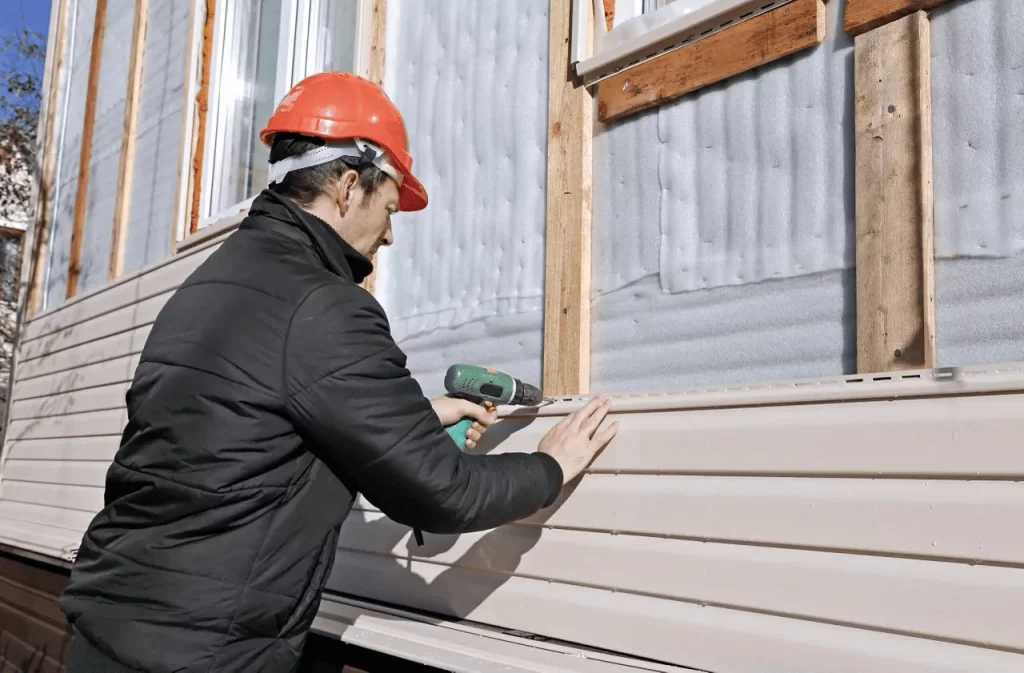
Regarding the basic concept, fire resistant siding is a material made of unique non-combustible components, such as fiber cement and gypsum fibers. Each of these materials has different properties and levels of fire resistance, but the common feature is that they do not support combustion and do not spread the fire further. Fire resistant house siding is designed to significantly reduce the temperature on the surface of the walls when flames are raging outside. With such a siding, you can preserve the integrity of the house’s structure for longer.
In addition, apart from the fire, this type of siding protects against UV rays, moisture, and other external factors. This makes it a versatile choice for modern homeowners who want to protect their homes from threats.
How it differs from standard siding materials
The main difference between fire resistant siding and standard materials is its ability to resist flames and high temperatures. For instance, common vinyl siding, which is widely used in construction, can melt under the influence of high temperatures, which accelerates the spread of fire. Wood siding also has low fire resistance because it is a natural fuel for flames. In both cases, the fire can quickly engulf the entire building, leaving little time to save property or evacuate.
Unlike these materials, fire resistant siding for homes is designed not to catch fire and not contribute to the spread of fire. An example of a highly favored fire-resistant siding material is fiber cement. It is composed of a composite blend of cement, sand, and cellulose fibers, making it an exceptionally durable and fire-resistant option for exterior cladding. It not only has a high fire resistance but is also resistant to rotting, corrosion, and other weather effects.
In addition to protective properties, fireproof house siding is distinguished by its durability and low maintenance costs. Instead of the frequent repairs and replacements that traditional materials often require, fire resistant siding maintains its properties for decades, making it a worthwhile investment for any homeowner.
Types of fire resistant siding
When choosing materials to protect a house from fire, it is vital to consider their aesthetic qualities and the level of fire resistance. The modern market offers multiple fire-resistant materials for houses, each with its own characteristics and advantages. Below, we’ll analyze some popular types of fire resistant siding.
Fiber cement siding
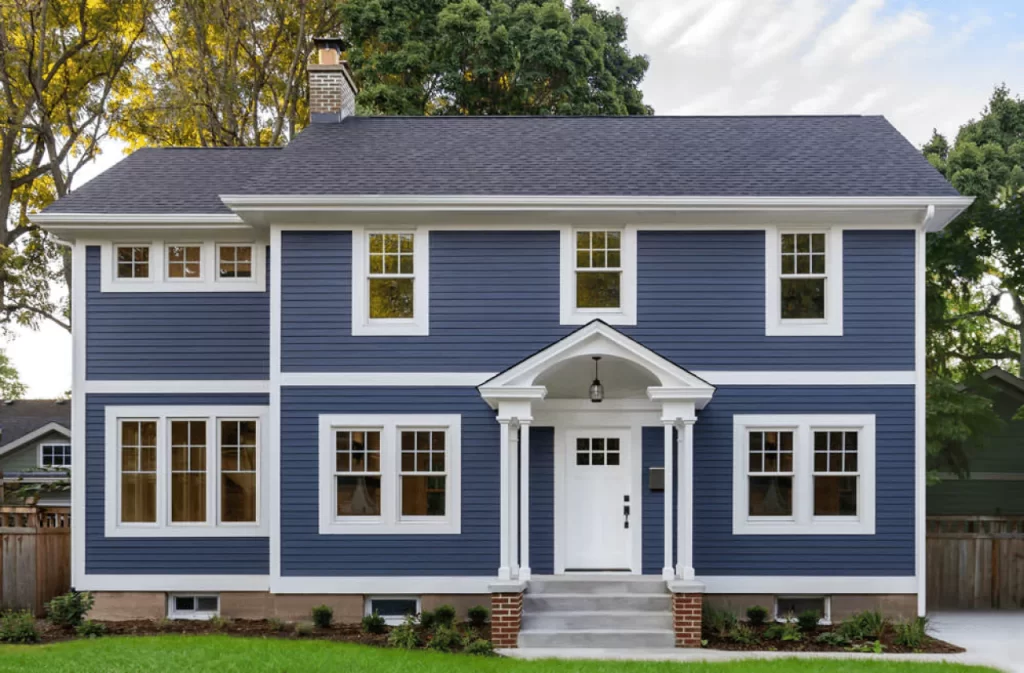
This siding is one of the most popular options for those looking for an effective and reliable way to protect their home from fire. This material is crafted from a blend of cement, sand, and cellulose fibers, offering excellent resistance to ignition and the spread of flames.
The main benefit of fire rated cement board is its ability to withstand extreme temperatures without damage and its resistance to other negative external influences, such as moisture, UV radiation, and rot. This type of siding has a long service life and requires little maintenance, making it an excellent choice for those looking to lower their home maintenance costs.
Fireproof cement board siding also offers various designs, imitating the look of wood, stone, or plaster. This allows you to combine high protection with an aesthetically attractive appearance.
Brick and stone veneer siding
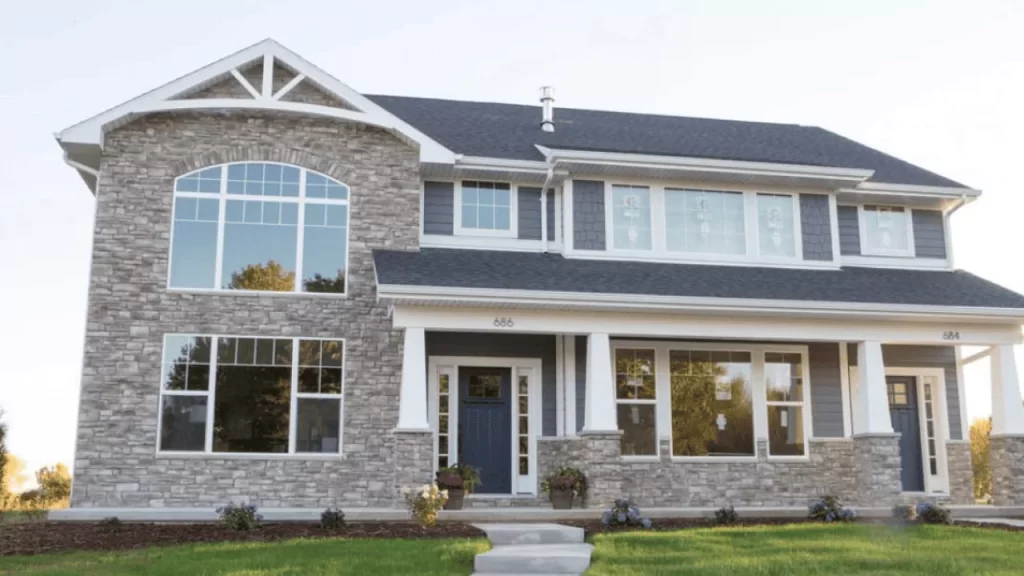
In fact, brick and stone siding is a classic exterior material known for its durability and fire resistance. The natural properties of stone and brick make them highly effective barriers against the spread of flames. They do not burn and can withstand high temperatures for long, providing your home with the highest fire protection.
Stone and brick also have other important advantages, such as resistance to moisture, wind, and mechanical damage. They have a very long service life, often exceeding several decades without needing to be replaced. However, these fire-resistant materials for houses are among the most expensive and require more time and resources to install than other types of siding.
From an aesthetic point of view, brick and stone siding adds bulk and solidity to a home, making it an attractive choice for those looking for protection and a classic, sophisticated look.
Stucco siding
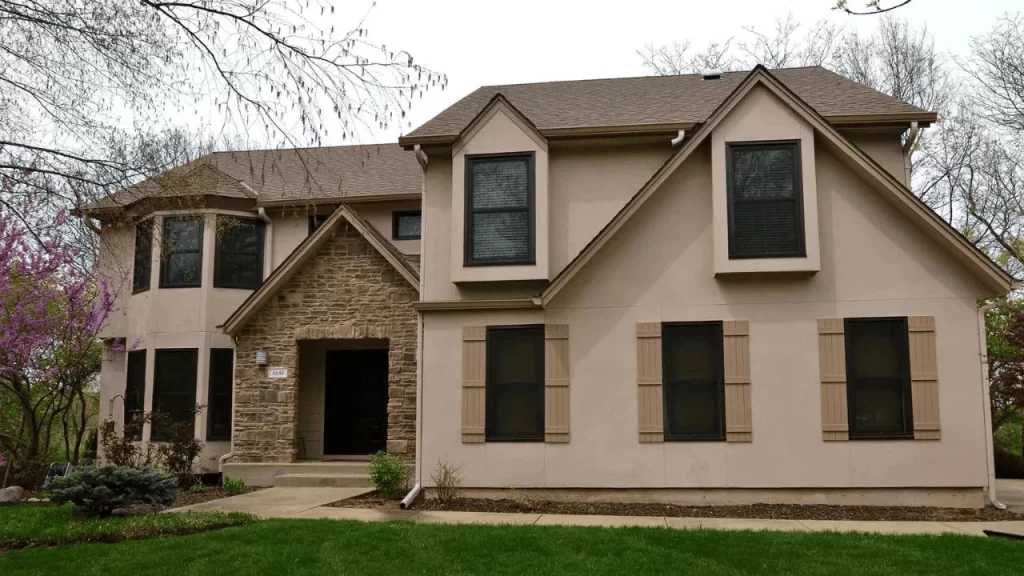
This fire resistant siding is another option that offers a high level of fire resistance. It is made from a mixture of cement, sand, and water applied to a special base. After drying, the plaster forms a hard and stable surface that can withstand fire, preventing it from spreading to the house’s structure.
Stucco siding also has excellent thermal insulation properties, which allow you to stay warm in winter and cool in summer. It also provides outstanding protection against moisture, which is why it is often chosen for regions with high humidity.
However, as with other materials, stucco requires professional installation and regular maintenance to preserve its quality. Cracks that may develop over time should be repaired immediately to prevent moisture ingress and loss of fire resistance.
Treated wood siding
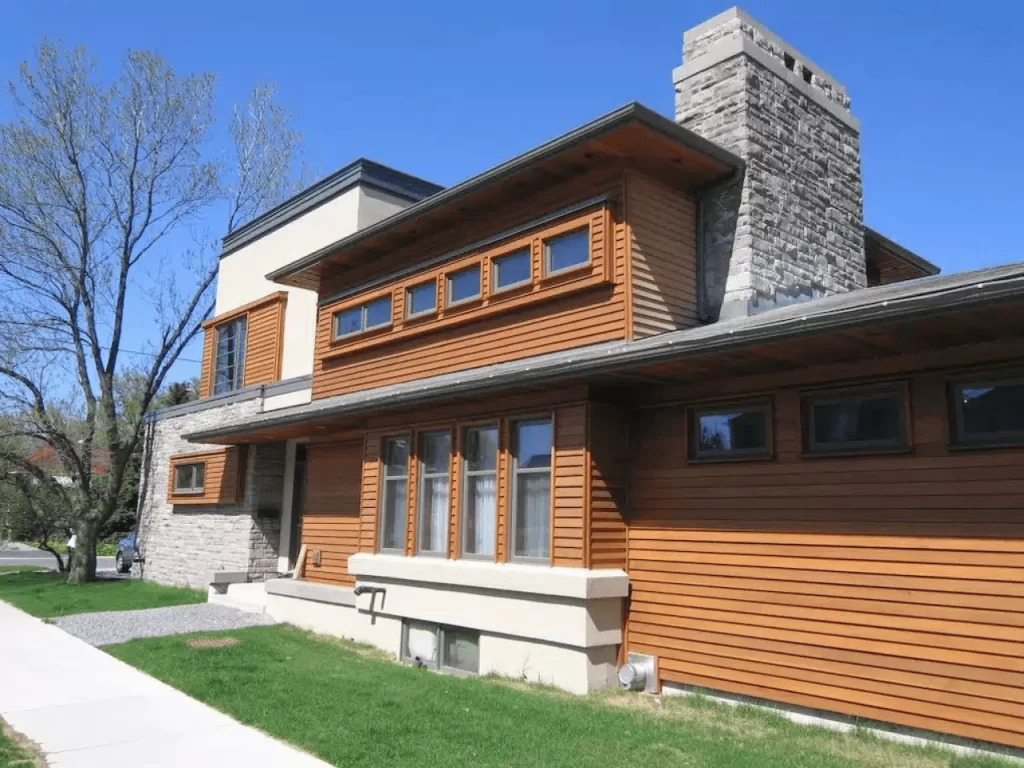
Fire resistant wood siding, treated with special fire-retardant substances, is an alternative for those who want to preserve their house’s natural appearance while increasing its fire resistance. Wood treated with chemical or thermal methods becomes less flammable, reducing the risk of fire.
Even though wood remains an organic material and can potentially burn, treatment with special flame retardant compounds is a solution. It significantly extends the time during which the wood can withstand the effects of high temperatures. This solution does not provide 100% fire protection, but it is an excellent compromise to ensure natural beauty while increasing safety.
In addition to fire resistance, treated wood is attractive, harmoniously fits into the landscape, and gives the house a warm and cozy look. However, this material requires regular maintenance, including periodic re-treatment with flame retardants to preserve its properties.
Benefits of fire resistant siding
Protecting the home from fire is one of the critical challenges for homeowners, especially in areas with a high risk of wildfires or in densely populated areas where the risk of ignition increases. Fire resistant siding is an effective solution that provides reliable protection and increases your home’s security level. However, besides the obvious advantage of fire resistance, siding has several other significant benefits that make it a good choice for any home.
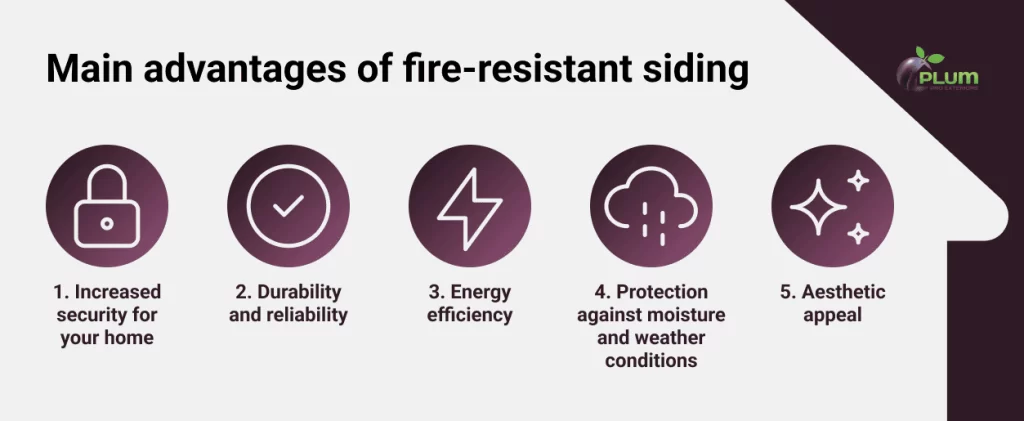
1. Increased security for your home
The primary benefit of fire resistant siding lies in its capability to endure extreme temperatures and inhibit the spread of flames. Materials like fiber cement, brick, stone, or specially treated wood can greatly minimize the possibility of a structure igniting during a fire incident. They can withstand high temperatures and provide extra time to evacuate and call the fire services, which is critical in an emergency.
2. Durability and reliability
Fire resistant siding is distinguished by its ability to withstand the effects of flames and its overall durability. For example, fiber cement, brick, and stone materials have a long service life, often exceeding several decades. They are resistant to negative external influences, such as rain, snow, and ultraviolet radiation, and are not susceptible to rotting or corrosion. This allows homeowners to save money on frequent repairs or replacement of cladding.
3. Energy efficiency
Another important advantage of fire proof siding is its ability to provide additional thermal insulation. Many types of such materials have excellent thermal insulation properties that help keep cool in summer and warm in winter. This allows you to reduce heating and air conditioning costs, providing comfortable living conditions throughout the year. In addition, energy-efficient materials help reduce carbon dioxide emissions, positively affecting your home’s environmental friendliness.
4. Protection against moisture and weather conditions
In addition to fire resistance, materials such as fiber cement or stone provide excellent protection against moisture. They are not susceptible to warping, rotting, or swelling under the influence of rain or snow, which is a serious problem for some standard cladding materials. Fire resistant siding is also resistant to ultraviolet rays, does not burn out in the sun, and retains its original appearance for a long time. This makes it an ideal choice for regions with harsh climatic conditions.
5. Aesthetic appeal
An important aspect when choosing facing materials is their appearance. Fire resistant siding offers a wide variety of textures, colors, and styles, allowing you to find the perfect solution for any type of home. For example, fiber cement siding can mimic the look of wood, stone, or even plaster, combining an attractive appearance with a high level of protection. Brick or stone panels add solidity and a classic look to a home, while stucco siding can provide a sleek and modern design.
Factors to consider when choosing fire resistant siding
In addition to the basic characteristics of fire resistance, when choosing facing materials, you should consider several key factors that will help you select the optimal solution for your home. Let’s check these factors in more detail below.
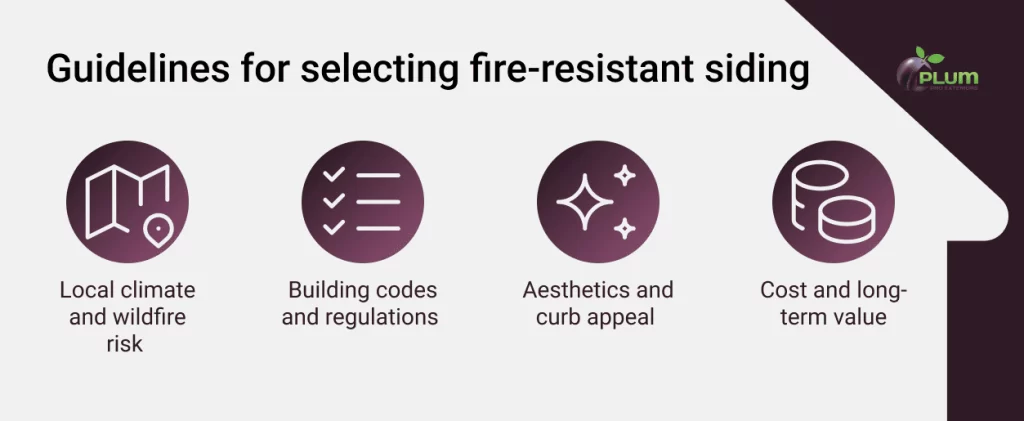
Local climate and wildfire risk
The first and most obvious factor in choosing fire resistant siding is your area’s climate, including the likelihood of fires. Choosing siding with high fire resistance properties is vital in areas with an increased risk of wildfires or frequent outbreaks due to drought. For example, fiber cement siding or brick panels may be ideal for such areas as they are non-combustible and do not support the spread of flames. In areas with strong winds and a lot of dry leaves, you should choose materials that have fire-resistant properties and resist mechanical damage.
It is also worth paying attention to the factor of moisture and rain. If your area is known for frequent downpours, choosing siding that combines fire resistance with water resistance and resistance to corrosion or rot, such as fiber cement or stone, is essential. Thus, the selection of siding should be based on climatic risks and weather conditions in your region. This will reduce the threat of fires and keep your home safe.
Building codes and regulations
Building codes and regulations have a huge impact on the choice of fireproof siding. Each region has its own requirements for the use of building materials, particularly those related to fire resistance and environmental safety. Be sure to check your local building codes and laws to ensure the siding you choose meets all requirements.
Such requirements usually include classifying materials by fire resistance, some of which must withstand a specific time of exposure to high temperatures without catching fire. For example, fiber cement panels have a fire resistance class A, which makes them one of the safest materials for use in residential buildings. In some cases, especially in areas of increased fire risk, local authorities may require exclusively non-combustible materials.
Aesthetics and curb appeal
The exterior of your home is something you see every day and is also an important factor in the property’s market value. Fire proof siding must protect your home and meet your aesthetic requirements. Fortunately, today’s fireproof materials are available in a wide range of textures, colors, and styles that can satisfy even the most discerning taste.
Fiber cement siding allows you to get the look you want without sacrificing safety. Brick and stone options give your home a classic, solid look that emphasizes its status and reliability. If you prefer a more modern look, stucco siding can create a sleek, minimalist style.
Thanks to a wide selection of designs, you can find an option that will perfectly complement the architecture of your home, emphasize its advantages, and provide reliable protection.
Cost and long-term value
Like any building material, the cost of fire resistant siding plays an important role in the selection process. Nonetheless, it’s crucial to keep in mind that cost shouldn’t be the sole consideration in your decision-making process. While fire-resistant siding may come with a higher price tag compared to traditional siding options, it represents a worthwhile investment in long-term safety and potential savings.
Materials with high fire resistance, such as fiber cement, stone, or brick, may have a higher initial cost, but they have a long life and do not require frequent maintenance. Add to that their energy-efficient properties, which allow you to save on heating and cooling your home, as well as their ability to increase the market value of your property, and you have a significant long-term benefit.
Moreover, fireproof siding for houses can lower your insurance costs, as homes with increased fire protection usually receive discounts on insurance policies. Therefore, when evaluating the cost, you should consider the initial costs and the benefits you will receive in the long run.
Conclusion
Choosing fire resistant siding is an essential step in ensuring the safety and longevity of your home. By investing in fireproof siding, you get reliable protection that can prevent major losses and provide peace of mind for the whole family. Remember that selecting quality material and professional installation is a matter of comfort and safety of your home for many years.
If you are looking for a reliable way to protect your home from fires and other natural disasters, our siding company is ready to help you make the right choice. Contact us today to keep your home safe and attractive for years.
FAQ
- What type of siding is fire-resistant?
Several types of siding are fire-resistant, with fiber cement and brick among the most popular choices. Fiber cement siding mixes sand, cement, and cellulose, offering excellent fire-resistant properties. Brick and stone, while more expensive, also provide superior protection.
2. What is fire-resistant cladding?
Fire-resistant cladding is an exterior covering designed to withstand high temperatures and prevent fire from spreading. It is typically made from non-combustible materials like fiber cement or stone and is often used in buildings that require higher safety standards.
3. What siding won’t burn?
Siding materials that won’t burn are those made from non-combustible substances like fiber cement and brick. These materials do not ignite or catch fire, making them ideal for areas prone to wildfires or buildings requiring enhanced fire protection.
